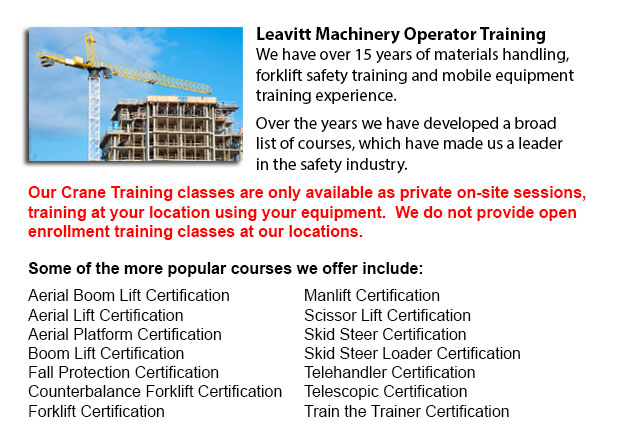
Crane Certification Marysville - The Crane Certification training program consists of subject matter suggested by industry concerning the efficient and safe operation of cranes. People training would know the following: pre-operational, operational and post operating requirements; how to identify cranes and their component parts; rigging components and inspection/rejection criteria; how to determine overall lift capacity; and requirements particular to the work place where the trainees will be operating.
The requirements that have to be performed prior to operating a crane like for example assigning authority for the pre-operational check; carrying out the sequential pre-operational check based on the specifications certified by a professional engineer or manufacturer's specifications; checking the log book for comments; checking the work place for obstacles and hazards; inspecting chains, cables, hooks crane movement and safety latches; making sure of the right functioning of operational controls; and knowing how to ensure the crane's disconnect switch/isolator is working correctly.
The requirements to operating a crane will consist of the identifying of responsibilities and roles, and the determination of the requirement for a formal lift plan. The person training will learn how to do danger assessments for the different environmental conditions, physical situations and employees. Subject matter consists of determining when to seek competent aid, the destination of loads and the safest route, and centre of gravity and load weight.
People training should be able to identify an over-capacity lift, in addition to be able to select appropriate rigging machinery, choose load restrictions, and to determine the safe position for the crane to operate from. Individuals training will review both site-specific and universal crane signals for lifts, and methods for traveling, lifting and loading. Correct maintenance habits will be covered.
The trainee would undergo an examination to test their knowledge of emergency response procedures for various situations, specifically electrical or mechanical failures. They would be asked to describe parking and shut down procedures for security and safety, to follow lock out and tagging techniques, and to explain why near misses are reported and recorded to the appropriate individual. Log book records must be maintained.
People training will develop knowledge of rigging, in particular, establishing who has authority and responsibility for rigging, identifying various kinds of rigging, knowing storage procedures and load capacity ratings.
Post-operational requirements consist of entering deficiencies or defects, maintenance and service history within the log book, according to state, provincial and federal codes requirements.
Site-specific needs can be included into the safety training program according to the employer's needs.
-
Manlift Safety Training Marysville
Manlift Safety Training Marysville - It is important for experienced Manlift operators to be aware of the connected hazards which come with particular types of scissor lifts. They must be able to operate the scissor lift in a way that protects not on... More -
Forklift Operator Certification Marysville
Forklift Operator Certification Marysville - Forklift operator certification is normally required for employees working in industrial, warehouse or construction environments to guarantee the safe utilization of forklifts. Workplace training need to f... More -
Crane Training School Marysville
Crane Training School Marysville - The crane training school offers industry-relevant programs. Courses provide trainees with learning outcomes that match present industry demands. Our small class sizes combine hands-on experience and theory. Our ind... More -
Heavy Equipment Training Marysville
Heavy Equipment Training Marysville - Normally, the different kinds of heavy equipment training are divided into 2 categories of machines: those that have rubber tires and tracked vehicles. Tracked vehicles comprise items like cranes, bulldozers and... More -
Counterbalance Forklift License Marysville
Counterbalance Forklift License Marysville - Forklifts, when operated by fully trained workers, are a major advantage to companies. We provide a thorough training program covering all aspects of operating a powered lift device. Counterbalance forklif... More -
Boom Lift Safety Training Marysville
Boom Lift Safey Training Marysville - Boom lifts are a type of elevated work platform or aerial lifting device which are normally utilized in warehousing, construction and industry. Boom lifts could be used in virtually any environment due to their v... More -
Aerial Lift Training Marysville
Aerial Lift Training Marysville - An aerial work platform is a mechanical access platform. This particular machinery provides access to otherwise not accessible areas for equipment or people. Likewise called an elevating work platform or aerial devic... More -
Aerial Boom Lift Training Marysville
Aerial Boom Lift Training Marysville - For people who operate or supervise the utilization of aerial lift platforms, right aerial boom lift Training is necessary. The aerial lift platform is for lifting people, materials and tools to elevated work lo... More

Forklift Training Marysville
TOLL FREE: 1-888-254-6157
Marysville, Washington
forklifttrainingmarysville.com
Email Us
About Us


